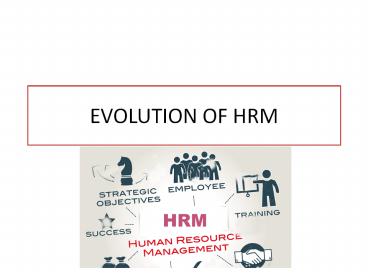EVOLUTION OF HRM - PowerPoint PPT Presentation
Title: EVOLUTION OF HRM
1
EVOLUTION OF HRM
2
HRM
- The history of HRM can be traced to
- England
- .Employees(masons, carpenters, leather workers,
and other craftspeople) organized themselves into
guilds/association/unity. - They used their unity to improve their working
conditions.
3
INDUSTRIAL REVOLUTION
- The field further developed with the arrival of in
dustrial revolution - in the latter part of the 18th century.
- The industrial revolution
- was characterized by- a new and complex industria
l society.- The substitution of steam power
and machinery foretime-consuming hand labor - The significant change in the working conditions,
social patterns, and the division of labor - A new kind of employee-a boss, who
wasn't necessarily the owner, as had usually been
the case in the past-became a power - With these changes also came a widening gap
between workers and owners
4
SCIENTIFIC MANAGEMENT
- Scientific Management,
- Welfare work and Industrial Psychology
- In the 19thcentury,Scientific management ,
welfare work and industrial psychology
emerged concurrently and merged during the world
wars. - .1.ScientificManagement
- dealt with inefficiencies in labor and management
through work methods, time and motion study, and
specialization - The renowned father of scientific management was
- Fredric WTaylor
5
ORIGIN OF HRM IN INDIA
- Itsoriginisdatedbackto1800B.C.,whenwageandincentiv
eplanswereincluded. - Theworldsfirstmanagementbook,titledArthasastawritt
enbyKautilya,duringChaldeansin400B.C.,codifiedmany
aspectsof humanresource practices in
AncientIndia.
6
1920S
- During 1920s jobs with the titles of labour
manager or employment manager came in to begin in
the engineering industry and other industry where
there were large factories to handle absence,
recruitment,dismassal and queries over bonuses
and so on.
7
1930s
- During 1930s with the economy beginning to pick
up, big corporations in these newer sectors saw
value in improving employee benefits as a way of
recruiting, retaining and motivating employees. - But older industries such as textiles, mining and
ship building which were hit by the worldwide
recessions did not adopt any new techniques
because they do not have any difficulty in
finding labour.
8
EARLY PHASE
- HRM in India could be traced back to the period
after 1920, when emphasis was on worker welfare - In 1931, the royal commission on labour suggested
the appointment of labour officer to protect
workers interests.
9
FIRST PHASE
- Immediately after independence the focus wason
four reasons - Maintain discipline
- Prevent their formation of and break-up the
leadership of trade unionism. - Handle recruitment and termination
- Keep some form of attendance and personnel
records
10
SECOND PHASE
- In1960s,Indianindustrializationgotafillipwiththeri
seofthepublicsector.Hence3morefunctionswereaddedi.
e.,LabourWelfare - Participative Management
- Industrial Harmony
- In this period,the human relations movement of
the west also had its impact on indian
organizations.
11
THIRD PHASE
- In1970,thepeoplemanagementfunctionwasneatlydivided
intotwo - Personnel officers.
- Establishment officers.
12
FOURTH PHASE
- In 1976, birth of worker training institute and
attitudinal development.
13
FIFTH PHASE
- In 1985 Organization shifted towards making HR
Department Seperatly. - HRD and Personnel Function were clubbed together.
14
SIXTH PHASE
- Early 1990s
- HRM was seen as strategy.
- Motivation and stress were considered to bring
change in HRM. - Focus on organization objectives.
15
SEVENTH PHASE
- In the mid of 1990s, Sub Specalizations like.
- Industrial Relations
- Training Development
- Information System
16
EIGHT PHASE
- In 1999
- HRM was not a selective management anymore It
became the part of Corporate Strategy Formulation
and Strategy - Implementation team.

